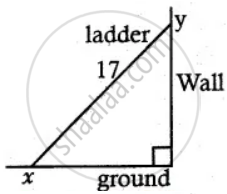Advertisements
Advertisements
प्रश्न
A ladder 17 metre long is leaning against the wall. The base of the ladder is pulled away from the wall at a rate of 5 m/s. When the base of the ladder is 8 metres from the wall, at what rate, the area of the triangle formed by the ladder, wall, and the floor, is changing?
उत्तर

Let the height of the wall where the ladder touches are ‘y’ m.
The bottom of the ladder is at a distance of ‘x’ m from the wall.
Given x = 8, `("d"x)/"dt"` = 5
x2 + y2 = 172
Pythagoras Theorem
y2 = 172 – x2
= 289 – 64
= 225
∴ y = 15
Differentiating w.r.t. ‘t’
`2x ("d"x)/"dt" + 2y ("d"y)/"dt"` = 0 .....(÷ 2)
`x ("d"x)/"dt" + y ("d"y)/"dt"` = 0
`8(5) + 15 ("d"y)/"dt"` = 0
∴ `("d"y)/"dt" = 40/15`
= `- 8/5`
Area of triangle formed by the ladder, wall and the floor is A = `1/2` xy
Differentiating w.r.t. ‘t’
`"dA"/"dt" = 1/2[x ("d"y)/"dt" + y ("d"x)/"dt"]`
= `1/2[8(- 8/3) + 15(5)]`
= `1/2[(225 - 64)/3]`
= `161/6`
= 26.83
∴ Area of the triangle is increasing at the rate of 26.83 m2/sec.
APPEARS IN
संबंधित प्रश्न
A particle moves along a straight line in such a way that after t seconds its distance from the origin is s = 2t2 + 3t metres. Find the instantaneous velocities at t = 3 and t = 6 seconds
A camera is accidentally knocked off an edge of a cliff 400 ft high. The camera falls a distance of s = 16t2 in t seconds. What is the average velocity with which the camera falls during the last 2 seconds?
A particle moves along a line according to the law s(t) = 2t3 – 9t2 + 12t – 4, where t ≥ 0. At what times the particle changes direction?
A particle moves along a line according to the law s(t) = 2t3 – 9t2 + 12t – 4, where t ≥ 0. Find the total distance travelled by the particle in the first 4 seconds
A particle moves along a line according to the law s(t) = 2t3 – 9t2 + 12t – 4, where t ≥ 0. Find the particle’s acceleration each time the velocity is zero
If the mass m(x) (in kilograms) of a thin rod of length x (in metres) is given by, m(x) = `sqrt(3x)` then what is the rate of change of mass with respect to the length when it is x = 3 and x = 27 metres
A conical water tank with vertex down of 12 metres height has a radius of 5 metres at the top. If water flows into the tank at a rate 10 cubic m/min, how fast is the depth of the water increases when the water is 8 metres deep?
A ladder 17 metre long is leaning against the wall. The base of the ladder is pulled away from the wall at a rate of 5 m/s. When the base of the ladder is 8 metres from the wall. How fast is the top of the ladder moving down the wall?
Find the slope of the tangent to the following curves at the respective given points.
y = x4 + 2x2 – x at x = 1
Find the points on curve y = x3 – 6x2 + x + 3 where the normal is parallel to the line x + y = 1729
Find the tangent and normal to the following curves at the given points on the curve
y = x2 – x4 at (1, 0)
Find the tangent and normal to the following curves at the given points on the curve
x = cos t, y = 2 sin2t at t = `pi/2`
Find the equation of tangent and normal to the curve given by x – 7 cos t andy = 2 sin t, t ∈ R at any point on the curve
Find the angle between the rectangular hyperbola xy = 2 and the parabola x2 + 4y = 0
Show that the two curves x2 – y2 = r2 and xy = c2 where c, r are constants, cut orthogonally
Choose the correct alternative:
A balloon rises straight up at 10 m/s. An observer is 40 m away from the spot where the balloon left the ground. The rate of change of the balloon’s angle of elevation in radian per second when the balloon is 30 metres above the ground
Choose the correct alternative:
The position of a particle moving along a horizontal line of any time t is given by s(t) = 3t2 – 2t – 8. The time at which the particle is at rest is
Choose the correct alternative:
The abscissa of the point on the curve f(x) = `sqrt(8 - 2x)` at which the slope of the tangent is – 0.25?
Choose the correct alternative:
The slope of the line normal to the curve f(x) = 2 cos 4x at x = `pi/12` is
